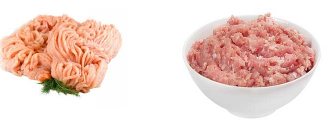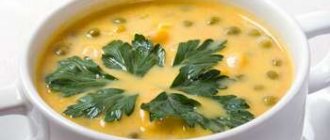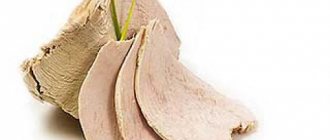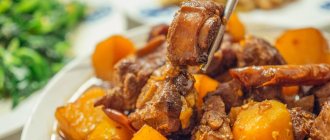Turkey meat, a poultry that came to us from the Western Hemisphere, is one of the dietary types of meat.
Poultry meat received this definition due to its beneficial properties, the presence of a large number of useful substances, as well as the virtual absence of fat and bad cholesterol.
Turkey meat is rich in amino acids necessary for the proper development of the body and easily digestible protein; meat is prescribed both in therapeutic and in diets for weight loss.
On sale in our stores you can find several varieties of turkey meat, divided into parts of the bird’s body - fillet (breast), wings, thighs, drumsticks, as well as offal (liver, heart).
If a person needs to eat the least high-calorie, fatty foods to create a diet, then turkey meat will be one of the best options for preparing tasty and healthy dishes.
Naturally, each part of the carcass is slightly different in calorie content. Therefore, you need to proceed first of all from the recommendations of a doctor or nutritionist.
- The lowest calorie part of this poultry is considered to be the turkey breast and fillet.
The calorie content of this product without skin is only 84 kcal per 100 grams. - The thigh and drumstick will outpace the breast by a few calories - 144 kcal per hundred grams.
- Wings - up to 191 kcal.
Lower than all its other parts - 84 kcal per 100 grams. This part can be given as a first meat course to small children - no allergies, no harmful substances unnecessary for a growing body.
To avoid inaccurate calculations of calorie content, it is necessary to remove the skin, and also avoid preparing the dish by frying in vegetable oil.
In addition to breast and fillet on a diet, you can use turkey thigh as food, calorie content
which is 144 kcal per hundred grams.
Turkey will be an excellent substitute for chicken, pork or veal meat, especially since it is practically the same in price.
Turkey fillet calories
Naturally, the calorie content of boiled turkey is less than that of fried turkey. This happens because during heat treatment, a certain amount of protein, as well as fat, is released into the water.
In turkey, the skin is considered the fattest part of the carcass - if you separate it from the meat, then almost all the fat remains with the skin. Turkey wings, unfortunately, are not skinned, but when boiled they have slightly fewer calories than when fried.
So, boiled turkey parts have the following number of calories:
- breast – 85 kcal;
- thigh – 145 kcal;
- wings – 150-190 kcal.
The simplest recipe for boiled turkey is preparing boiled fillet.
- You need to cook the fillet for at least an hour and a half, but you shouldn’t overcook it either, otherwise the meat will become tough.
- You can add salt before and during heat treatment, but pepper (if you like it spicy) should be added to the raw product.
- After the cooking process is completed, the sirloin is cut into neat pieces, sprinkled with parsley and served.
- The dish can be eaten both hot and cold – the taste in both forms will be excellent.
Turkey fillet: calorie content and beneficial properties
One hundred grams of turkey meat contains 19.2 g of protein and 0.7 g of fat. In turkey breast, the calorie content is 84 kcal per 100 g, and in turkey fillet, the calorie content is 194 kcal per 100 g. This composition allows turkey meat to be used in the diet of people who have suffered serious illnesses, as well as those who lead an active lifestyle. In addition, turkey has a balanced composition of vitamins and microelements. In particular, it is rich in B vitamins and contains the daily amount of vitamin PP in one medium serving.
In terms of the amount of phosphorus, turkey is comparable to fish, and iron from its meat is perfectly absorbed. The selenium contained in turkey is necessary for the human body to maintain youth and prevent cancer, and magnesium is required for the normal functioning of the nervous system.
Beneficial features
As mentioned earlier, turkey breast is highly nutritious, low in calories and hypoallergenic. An extremely easily digestible product, therefore breast is allowed to be consumed by infants as the first complementary food. Recommended by experts for use by women expecting a child, as well as breastfeeding. No less useful for older people and people with an active lifestyle. Turkey breast helps maintain immunity due to the content of many useful substances, and also normalizes the functioning of the cardiovascular system. It is used in the form of therapeutic nutrition for patients with tuberculosis, or other severe or chronic diseases.
Dietary turkey dishes. Calories
In dietary nutrition, turkey dishes are extremely highly valued due to the lack of cholesterol in them. Dietary turkey dishes are indispensable for athletes and those losing weight, as they allow you to build muscle mass without adding extra centimeters to your waist.
To reduce the already low calorie content of turkey, it is necessary to remove the skin from it before cooking, since fat is located in the subcutaneous layers. Among other things, turkey meat contains serotonin, which is necessary in the fight against extra pounds. Turkey meat has a pleasant taste and does not require complex cooking.
For example, to prepare turkey fillet with a vegetable side dish, the poultry flesh will need to be cut into small pieces. Cut carrots, onions, bell peppers and mushrooms into cubes, place in a baking dish on top of the turkey flesh, cover with foil and bake in the oven until tender, after adding salt and pepper. Generously decorate the finished dish with chopped herbs. If desired, you can serve it with rice or use it on its own.
A wonderful low-calorie turkey dish is roasted thigh with marjoram. The turkey thigh is washed, dried and fried in olive oil in a preheated frying pan on both sides for several minutes.
The fried leg is transferred to a baking dish, poured with oil from the frying pan and baked in the oven until half cooked. Then sliced onions, potatoes and apples are added to the turkey. The whole thing is seasoned with thyme, salted, poured with a small amount of dry white wine and baked until fully cooked.
Low-calorie turkey is used in Roman stew. The turkey flesh is cut into cubes and fried in olive oil. Then add chopped mushrooms, tomato paste and season with sage. After a few minutes, add cream, dry white wine and a little flour. Served with pasta.
A tasty and healthy dish is turkey fillet with beans in pots. Pre-soaked red beans are boiled. Turkey fillet is cut into small pieces and fried in olive oil with chopped vegetables: onions, carrots and garlic. Season with marjoram. A little dry white wine is poured into each portioned pot, a layer of beans is laid out, and then a layer of meat with vegetables, salted, covered with a “lid” made from store-bought puff pastry and baked in the oven until cooked.
Low-calorie turkey (breast) is also hypoallergenic, therefore it is widely used in children's nutrition.
Dec-17-2012
Turkey breast meat, or, as we used to say, turkey (aka turkey meat) is a tender type of meat, similar in properties to rabbit meat, since it also contains a little fat. But turkey meat is less smooth-fibered, which is what makes turkey different from rabbit meat. Turkey meat is quite popular, apparently, which is why many are interested in the questions: what calorie content does turkey have and what are the benefits of turkey, or rather turkey meat.
Low calorie turkey and its uses
Considering how many calories there are in turkey, it is one of the best protein options for low-calorie diets. Turkey meat is an integral part of therapeutic diets, as well as nutrition for athletes. Due to the fact that turkey is high in protein and low in fat, it does not contribute to the accumulation of fat mass, but allows you to build muscle.
The low calorie content of boiled turkey makes it an excellent product for pregnant and nursing mothers. This meat will not cause excess weight, but the baby will be provided with all the necessary nutrients. Turkey fillet can also be your baby's first meat meal.
Due to the low calorie content of turkey breast and its neutral taste, it is widely used in cooking. This meat is very tender, it does not require long cooking and is suitable for preparing a wide variety of dishes. Turkey meat can be boiled, stewed, fried, baked in the oven and on the grill; it is suitable for making cutlets, rolls and any other meat dishes. In the United States, the most famous turkey dish is the traditional stuffed Thanksgiving turkey.
To keep turkey fillet low in calories, you should boil it, then you can not worry about the calorie content of the dish and just enjoy its taste. It is best to steam the turkey, then it will retain all the beneficial substances and will be as beneficial as possible for digestion. It is very useful to eat meat with boiled vegetables; this will not increase the calorie content of turkey breast.
There are practically no contraindications to eating turkey. But, like any other meat, turkey fillet contains a lot of protein, so hypertensive patients, people with gout and kidney failure should not abuse it.
Dietary properties of turkey:
Turkey, the calorie content of which we will consider in our article, is a dietary type of meat, therefore its beneficial qualities are successfully used for the benefit of sick and weakened people. If we consider the content of vitamins and mineral components in it, we can conclude that turkey is one of the most balanced foods of animal origin.
The methods for preparing turkey meat are no different from those for any other type of meat. Turkey is stewed, baked, boiled, fried, smoked, etc.
If we consider a product such as turkey meat, then it should be noted that per 100 grams of turkey meat there is only 1 gram of fat. Turkey contains quite a lot of protein, approximately 20 grams. Thanks to such a unique ratio of nutrients required by our body, the calorie content of turkey is relatively low.
Turkey, like no other type of meat, contains large amounts of vitamin B3, phosphorus and selenium, as well as a very useful amino acid - tryptophan.
Turkey meat is healthy:
- for diseases of the heart and blood vessels (contains potassium and selenium);
- for diseases of the stomach and intestines (easily digestible);
- good antioxidant - serves to prevent various cancers;
- for allergy sufferers and children under one year of age (as it never causes allergies);
- for nervous disorders (contains iron, calcium, magnesium, zinc, vitamin E);
- for depression (thanks to vitamin B5).
This is due to the fact that turkey meat:
- promotes long and sound sleep;
- improves skin condition, prevents dryness and cracks (it contains a lot of vitamin E);
- strengthens bone tissue, teeth, nails and hair (calcium, fluoride, vitamins B, A, and D);
- increases male potency (zinc and again vitamin E).
There are no contraindications to eating turkey meat.
The permissible dose of turkey meat for an adult is from 150 to 200 g per day.
Well, what exactly is it? And here it is:
Turkey as a menu item for weight loss
Turkey fillet and breast are considered the most suitable for weight loss, since these parts of the bird are the lowest in calories. Turkey meat helps keep muscles toned and saturates the body with minerals and vitamins necessary for normal functioning.
The recommended daily dose of product consumption is 250-300 g, for weight loss – 150-200 g.
With regular consumption of poultry meat, the digestion process improves, due to which metabolism accelerates, and additional energy appears in the body, which stimulates the body to be active (in the case of those losing weight, to play sports).
For weight loss purposes, the method of preparing poultry is important. The most suitable option is baking in the oven, boiling, steaming or grilling.
A little information on cooking time:
- breast or fillet must be cooked for half an hour;
- thigh or lower leg - within one hour;
- whole carcass – at least three hours;
- It takes at least two and a half hours to bake a whole bird (4 kg).
For the marinade, you cannot use sour cream or mayonnaise; you should limit yourself to lemon juice, various spices, soy sauce, wine vinegar, garlic, mustard. You can use a small amount of honey.
© Andrey Starostin — stock.adobe.com
The calorie content of turkey is 197 kcal per 100 grams of this product
Together with the skin, this figure increases to 216 kilocalories. Without any exaggeration, such figures can be called record-breaking.
However, we should also not forget that not all parts of this bird are the same in terms of the number of calories they contain. And this is completely natural. For example, turkey breast, without skin, has the lowest calorie content, since breast fillet contains only 84 kilocalories per 100 grams of product. Turkey legs already have a significantly higher calorie content, equal to approximately 142 kcal. But turkey wings will have even greater nutritional value - 168 kilocalories.
In a word – the choice is yours. You yourself can choose exactly what suits you for a healthy and dietary diet. Whatever the difference in calorie content of individual parts of a turkey, there is no doubt that this whole bird as a whole is an excellent option for those who would like to reduce body weight to acceptable levels or are simply concerned about their appearance.
What is the calorie content of turkey (breast) cooked in different ways? And here it is:
Calorie table for turkey, per 100 grams of product:
And the nutritional value of turkey cooked in different ways is as follows:
Table of nutritional value of turkey (BJU), per 100 grams of product:
What can you cook from turkey? Yes, a lot of things, like any meat. Here is one of many recipes for you:
Turkey baked in foil:
Products:
- — Turkey — 800g.
- — Lemon juice (you can use tomato puree) — 1 tablespoon
- — Onion — 1 onion
- — Parsley — 2 tablespoons
- — Parsley root (grated) — 1 teaspoon
- — Butter (you can use sour cream) — 2 tablespoons
- - Black pepper (ground) and salt - to taste
Cut the turkey into portions and place on foil. Each piece is sprinkled with well-chopped vegetables and spices, a piece of butter (or a little sour cream) is placed on top of it; You can also add fresh tomatoes. We wrap all this in foil so that the liquid does not leak out during baking. Then place the pieces of turkey in foil on a baking sheet and bake in the oven (temperature - 200C) for 40-50 minutes (for broilers - 20-30 minutes). Before removing the meat from the oven, you should test it with a needle to check for doneness.
The finished meat is served with foil so that it is in the resulting sauce. Boiled rice, potatoes, and fresh vegetable salad are suitable as a side dish. Eat for your health, and the low calorie content of turkey will not add extra pounds to you.
How to cook diet turkey cutlets
A very tasty and healthy dish is turkey cutlets. Thanks to the low calorie content of turkey, they are quite dietary and are suitable even for those on a low-calorie diet. For cooking you will need 500 kcal of turkey breast, an onion, corn flour for breading, an egg, spices and a little vegetable oil for frying.
Grind the meat with onions in a meat grinder and add the rest of the ingredients. To make the cutlets soft and juicy, you need to add a little water to the minced meat. The minced meat should turn out runny; spoon it into a plate with flour for breading and turn it over. A large oblong patty should form. You need very little flour, otherwise the chops will turn out rough. They need to be fried over medium heat. If the cutlets seem a little dry, you can simmer them under the lid.
Meat is necessary for the human body, because it contains vitamins and microelements that are difficult to find in dairy products and products of plant origin. Recently, the popularity of turkey meat has grown significantly in Russia, which was brought to Europe from the territory of modern America, where it is part of the most revered products. Turkeys are raised in Russia, but this does not happen on a large scale, since the turkey is a heat-loving bird. Meanwhile, we are happy to buy a breast or other part of a turkey carcass, from which we can prepare a large number of dishes, and in some families, a turkey cooked in the oven for New Year or Christmas turns into an iconic dish. We should not forget about the importance of turkey during the celebration of Thanksgiving Day, which came to us from the same America. Naturally, many people have a question - how many calories are in turkey, and “Particulars” will try to answer it. Com".
Turkey for weight loss
Turkey meat, which is rich in vitamins and minerals, is often included in various weight loss diets. A protein diet based on turkey meat is very popular; it helps the body lose extra pounds without harm, and helps a person positively shape his figure. But in order for the diet to bring only benefits, it is necessary to follow important basics:
You cannot follow a protein diet for more than 10 days.
The method of preparing turkey for weight loss is boiling, stewing, baking.
The right combination of turkey meat is vegetables (green peas, carrots, corn), rice. For a piquant taste, it is recommended to season the finished dish with spices and aromatic herbs.
To prevent digestive problems, it is important to drink kefir daily during the diet. In addition, the body must receive the required amount of clean water throughout the day.
If during the period of following the diet negative reactions of the body are observed, then it is necessary to urgently consult a specialist.
Turkey meat, a poultry that came to us from the Western Hemisphere, is one of the dietary types of meat.
Poultry meat received this definition due to its beneficial properties, the presence of a large number of useful substances, as well as the virtual absence of fat and bad cholesterol.
Turkey meat is rich in amino acids necessary for the proper development of the body and easily digestible protein; meat is prescribed both in therapeutic and in diets for weight loss.
On sale in our stores you can find several varieties of turkey meat, divided into parts of the bird’s body - fillet (breast), wings, thighs, drumsticks, as well as offal (liver, heart).
If a person needs to eat the least high-calorie, fatty foods to create a diet, then turkey meat will be one of the best options for preparing tasty and healthy dishes.
Naturally, each part of the carcass is slightly different in calorie content. Therefore, you need to proceed first of all from the recommendations of a doctor or nutritionist.
- The lowest calorie part of this poultry is considered to be the turkey breast and fillet.
The calorie content of this product without skin is only 84 kcal per 100 grams. - The thigh and drumstick will outpace the breast by a few calories - 144 kcal per hundred grams.
- Wings - up to 191 kcal.
Lower than all its other parts - 84 kcal per 100 grams. This part can be given as a first meat course to small children - no allergies, no harmful substances unnecessary for a growing body.
To avoid inaccurate calculations of calorie content, it is necessary to remove the skin, and also avoid preparing the dish by frying in vegetable oil.
In addition to breast and fillet on a diet, you can use turkey thigh as food, calorie content
which is 144 kcal per hundred grams.
Turkey will be an excellent substitute for chicken, pork or veal meat, especially since it is practically the same in price.
Turkey fillet calories
Naturally, the calorie content of boiled turkey is less than that of fried turkey. This happens because during heat treatment, a certain amount of protein, as well as fat, is released into the water.
In turkey, the skin is considered the fattest part of the carcass - if you separate it from the meat, then almost all the fat remains with the skin. Turkey wings, unfortunately, are not skinned, but when boiled they have slightly fewer calories than when fried.
So, boiled turkey parts have the following number of calories:
- breast – 85 kcal;
- thigh – 145 kcal;
- wings – 150-190 kcal.
The simplest recipe for boiled turkey is preparing boiled fillet.
- You need to cook the fillet for at least an hour and a half, but you shouldn’t overcook it either, otherwise the meat will become tough.
- You can add salt before and during heat treatment, but pepper (if you like it spicy) should be added to the raw product.
- After the cooking process is completed, the sirloin is cut into neat pieces, sprinkled with parsley and served.
- The dish can be eaten both hot and cold – the taste in both forms will be excellent.
How many calories are in turkey?
On average, for turkey meat, the calorie content gives a value of 276 kcal per hundred grams, but this is an average figure for a whole bird, which is usually prepared only for a large circle of people on holidays: in splendid isolation and even two or three people cannot eat this amount in a couple of days . As with any animal or bird, turkey has more and less fatty parts, as a result of which their calorie content also changes. Moreover, as in the case of chicken, offal with skin will be much “heavier” than pure meat. Therefore, understanding how many calories are in turkey requires parts.
The most nutritious part of turkey, like chicken, is considered to be the breast. The largest amount of tender and juicy meat is concentrated here, in contrast to the same wings, legs and neck, where there is solid skin, bones and cartilage. The calorie content for turkey fillet - a breast stripped of everything except meat - is 159 kcal per hundred grams. By and large, it is pure protein - 56%, and a relatively small part of fat - 40%. Yes, the last element is a little more than twice as high as for chicken fillet, but even unlike the fats in beef, they are much easier to digest from turkey, and therefore there is no need to worry. What is definitely worth noting, in addition to the calorie content of turkey fillet, is the absence of allergies to it, which allows you to feed this meat even to small children. And in the chemical composition, sodium comes to the fore, the proportion of which is so large that the breast does not need to be salted during the cooking process. This, of course, will not reduce the calorie content of turkey fillet, but it will allow people with hypertension to consume it, and is also a plus for the diet, since it is not recommended to abuse salt during the period of weight loss, because it prevents the removal of water from the body. Among the microelements that are slightly less significant in their content are potassium, magnesium, iron, sulfur and manganese, as well as phosphorus. The vitamin list includes vitamins B, A, and E. This allows not only to strengthen the cardiovascular and nervous system, increase the resistance of the immune system to viruses, but also to synthesize new blood cells, which is required for anemia. On the last point, turkey is actively compared to beef, but the calorie content of turkey - both fillet and other parts - is much lower, and its perception by the body is easier. Moreover, when boiled, the fillet will cost 103 kcal, and when baked on the grill – 118 kcal.
Turkey fillet can be prepared in any way: simply boil, bake, stew, steam, fry, or even grind into minced meat to later make cutlets, meatballs or meatballs. Minced turkey meat has a slightly higher calorie content than breast meat - 194 kcal, and the distribution between proteins and fats will be the opposite: 46% and 54%. This is explained by the fact that when rolling meat, a certain amount of fat from the poultry is necessarily added to the minced meat, otherwise the finished product will be a bit dry. However, such minced meat is many times lighter than minced pork, beef or veal.
Another offal that comes from turkey, and is often served baked or added to soups to create a meaty, rich broth, but not fatty like pork or beef, is turkey wing. The calorie content of this part of the bird is 197 kcal, which is primarily determined by the skin covering it. The meat in the wings itself is not tender or special in taste, and therefore requires rubbing with spices or soaking in a marinade. This will help not only get rid of the blandness, but also slightly reduce the calorie content of the turkey, as well as speed up the metabolism due to spices or vinegar. If you are preparing a broth, then using a whole wing is irrational, and it is too fatty: half or a third of it is enough to maintain the perfect balance.
Turkey drumsticks, whose calorie content is 144 kcal, also occupy not the least place. This is the best option between fairly fatty wings and dietary fillets, perfect for baking in various marinades and sauces, and for stewing and frying. True, fried meat is undesirable during the process of losing weight: its “weight”, due to the absorption of oil, jumps significantly, increasing the load on the liver and pancreas.
Harm of turkey and contraindications
To prevent turkey meat from causing harm, you must refrain from consuming it in case of individual intolerance or allergy to protein.
In addition, there are several specific contraindications:
- gout;
- kidney disease.
Using the product too frequently or violating the recommended daily allowance will negatively affect the health of people who:
- high blood pressure;
- obesity (especially when eating turkey fat or skin);
- increased blood cholesterol levels;
- last stage of cancer;
- diseases of the cardiovascular system.
In moderation, boiled or baked products cooked without skin and not in fat are allowed. Turkey skin is high in calories and harmful, so it is recommended to remove it before cooking.
The heart and liver contain large amounts of cholesterol, so they must be eaten carefully and in a balanced amount (100-150 g per day), especially for people with high blood cholesterol levels.
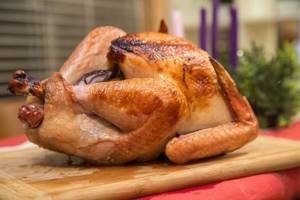
© WJ Media Design - stock.adobe.com
